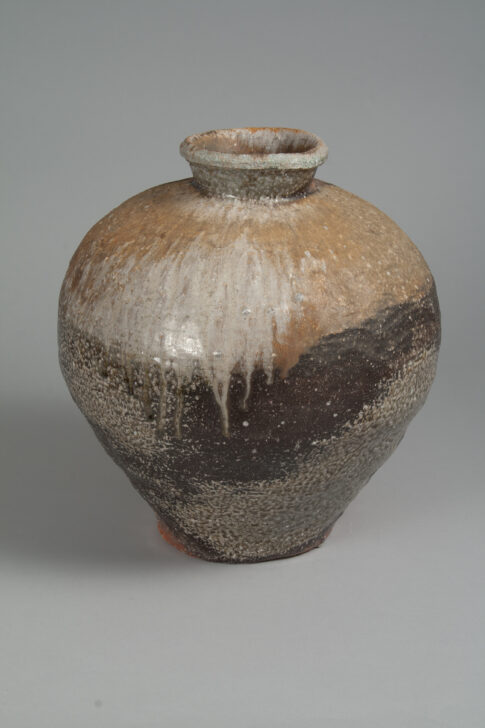Large Jar
Kōyama Kiyoko

Description
Kōyama Kiyoko
Japan, b. 1935
Large Jar
Heisei period (1989–2019)
ca. 2000
Stoneware with natural ash glaze
Gift of the artist, 2010/1.213
The life and career of Koyama Kiyoko—one of the
leading contemporary potters in the Shigaraki ware
tradition—are an eloquent testimony to what female
potters have struggled for and accomplished in Japan.
Like many other women potters, Koyama started out
as a painter who drew designs on pottery. Despite a
lack of support and financial difficulties caused by her
divorce from her potter husband, she was determined to
recreate a historic translucent green-white glaze using
unpredictable natural ash glazes. Here this glaze creates
a modern and expressive surface on a classic form—the
vessel’s shape is reminiscent of a historic Shigaraki ware
storage jar. Originally everyday wares for local farmers,
Shigaraki ware vessels became prized items among tea
ceremony practitioners in the Momoyama (1583–1615) to
early Edo (1615–1650) periods.
Spring/Summer 2021 Gallery Rotation
__________
One of the leading contemporary potters in the Shigaraki ware tradition, Kôyama Kiyoko’s life and career is an eloquent testimony to what female potters have struggled for and accomplished in Japan. Kôyama, like many other women, started as a painter who drew designs on pottery. Despite a lack of support and financial difficulties caused by her divorce from her potter husband, she was determined to recreate a historic translucent green-white glaze using unpredictable natural ash glazes. The shape of this jar is reminiscent of a historic Shigaraki ware storage jar, an example of which may be seen in this gallery. Originally everyday wares for local farmers, these jars became prized items among tea ceremony practitioners in the Momoyama (1583–1615) to early Edo (1615–1650) periods. Kôyama’s use of green-white natural ash glaze on this classic form creates a modern and expressive surface.
Gallery Rotation, Spring 2011
Gallery Rotation Spring/Summer 2011
Kôyama Kiyoko
Japan, born 1936
Large jar
circa 2000
Heisei Period (1989–present)
Stoneware with natural ash glaze
Gift of the artist, 2010/1.213
One of the leading contemporary potters in the Shigaraki ware tradition, Kôyama Kiyoko’s life and career is an eloquent testimony to what female potters have struggled for and accomplished in Japan. Kôyama, like many other women, started as a painter who drew designs on pottery. Despite a lack of support and financial difficulties caused by her divorce from her potter husband, she was determined to recreate a historic translucent green-white glaze using unpredictable natural ash glazes. The shape of this jar is reminiscent of a historic Shigaraki ware storage jar, an example of which may be seen in this gallery. Originally everyday wares for local farmers, these jars became prized items among tea ceremony practitioners in the Momoyama (1583–1615) to early Edo (1615–1650) periods. Kôyama’s use of green-white natural ash glaze on this classic form creates a modern and expressive surface.
Subject Matter:
This is a vase. The artist, Koyama Kyoko, struggled as a female potter in a trade dominated by male artists. She received recognition when she discovered a way to revive the forgotten techinique of natural ash glazes, which are commonly used in her work.
Physical Description:
This large jar is wider in the top portion, narrowing towards the base. It has a short neck that flares outwards. The natural glaze creates a range of browns and grays.
Usage Rights:
If you are interested in using an image for a publication, please visit https://umma.umich.edu/request-image/ for more information and to fill out the online Image Rights and Reproductions Request Form.